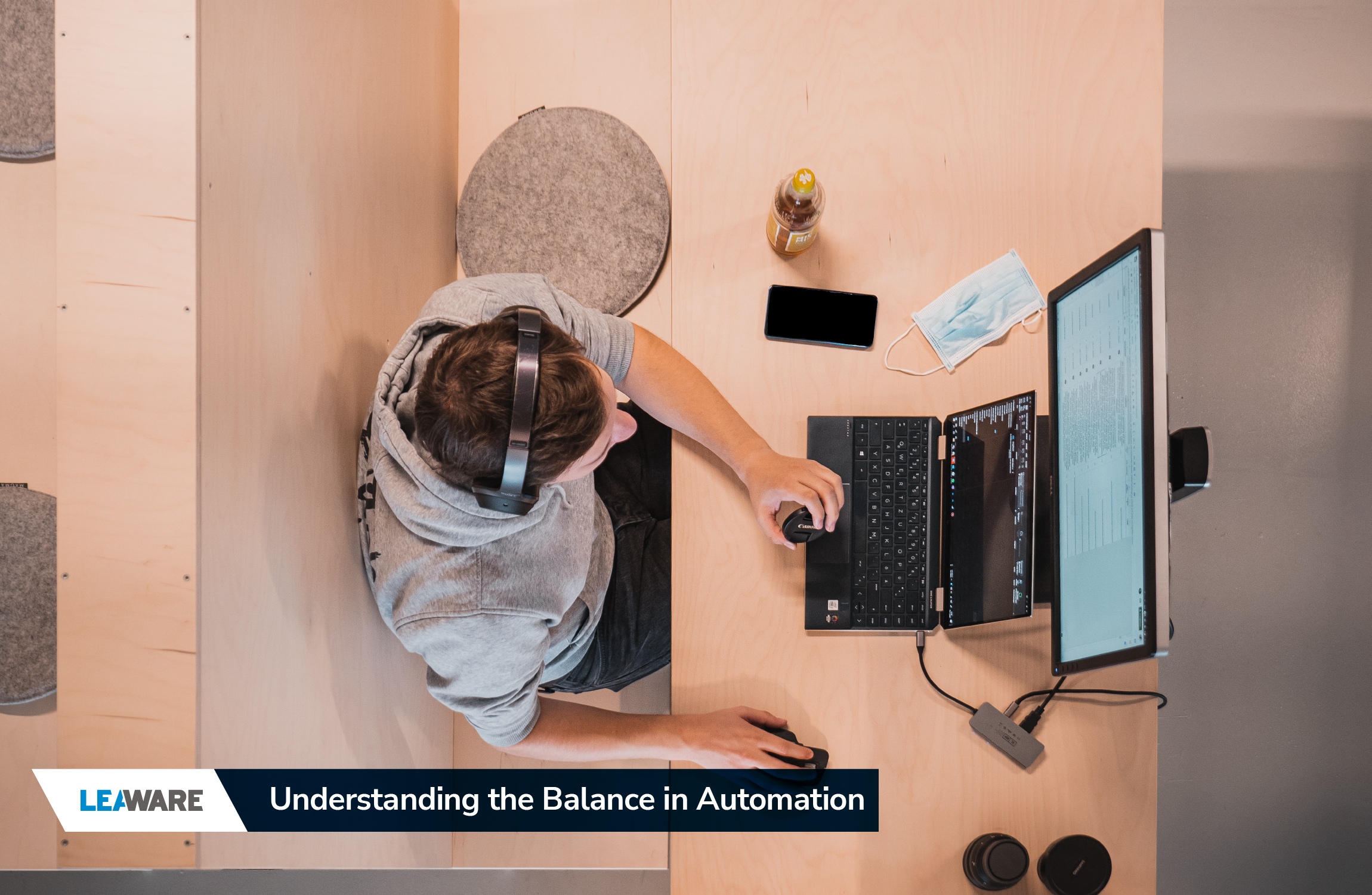Automation, When is it the Wrong Decision for Your Startup?
In the bustling world of startup businesses, the term ‘automation‘ has gained considerable traction. Business Process Automation (BPA) promises an increased efficiency, accuracy, and productivity, making it a tempting proposition. However, is it always the right decision? Our collective years of experience in BPA consulting have shown us that it isn’t always the case.

Understanding the Balance in Automation
In some instances, automating a process might not be the best decision. Therefore, we find it essential to share these scenarios with startup owners such as yourselves, who might be contemplating automation.
One of the primary concerns is the lack of control and flexibility. Some tasks inherently require human judgement, creativity, and an understanding of context. For instance, processes that demand complex decision-making or the ability to adjust swiftly to unexpected situations are often best left to humans. In these scenarios, automation could lead to rigidity, subsequently affecting the quality of outcomes.
Example
Let’s take the case of an online marketing startup that handles social media accounts for various businesses.
Let’s say the startup wants to automate its content creation process to streamline operations. However, they need to consider the nature of the work. Social media management often requires a deep understanding of the client’s brand voice, audience preferences, and the ability to respond creatively to real-time events or trending topics.
A fully automated system for content creation might lack the flexibility and creativity needed to adapt to these dynamic factors. For example, if a significant event occurs in a client’s industry, the automated system might not be able to create content that accurately reflects the company’s opinion or makes a timely response to the situation.
Moreover, the content created by an automated system might not resonate with the audience in the same way human-created content would. This is because understanding subtle cultural nuances, emotions, and humor, which are key to engaging social media content, is an area where automation still lags behind human capacity.
In such a case, while some level of automation could be beneficial (such as scheduling posts or analyzing performance metrics), automating the entire content creation process could lead to lackluster social media accounts that fail to engage the target audience effectively. Hence, maintaining a balance between human creativity and automation efficiency becomes crucial.
Is automation truly benefiting your startup, or could it be a costly misstep? Dive into the intricacies with our experts in a free consultation!, Click on the button!
Low Volume Tasks and Unstable Processes
Further, consider the volume of tasks. If a task is infrequent or the volume of work is low, the cost of automating the task may outweigh the benefits. Automation usually involves an upfront investment in time and money, which might not be justified for low volume tasks. As a startup, it’s important to judiciously allocate your resources.
The stability of a process also plays a vital role. If a process is unstable or is likely to change significantly in the near future, automating it might be ill-advised. The cost and effort of constantly updating the automated system could outweigh the benefits.
Example
Let’s use an example from a food delivery startup.
Consider a task such as managing large-scale marketing campaigns during popular holidays like Thanksgiving or Christmas. These are high-volume tasks that happen periodically and thus can justify the cost of automation, given the impact and scale of operations.
Contrarily, imagine the task of sending out personalized birthday coupons to customers. If the startup is still in its early stages with a limited customer base, this task could be considered a low-volume task. It’s infrequent, personalized, and the volume is low – perhaps a handful of customers have a birthday on any given day. The cost of creating and maintaining an automated system for this task might not be justified given the minimal time it would save.
In terms of unstable processes, suppose the startup is testing a new referral system to attract more customers. They’re unsure of the optimal referral bonus amount, the method of tracking referrals, and other elements of the system. They plan to change and optimize these elements based on initial feedback and performance. If they were to automate this process right away, they would likely find themselves spending considerable time and resources adjusting the automated system to accommodate these changes. In this case, it’s more efficient to handle the process manually until it’s stable and well-defined.
Related: Top 10 Warning Signs Your Software Development Project May Be Going Off Course.
Complex Processes and Human Interaction
Some processes are too complex to automate effectively. If a process involves multiple steps, requires different inputs at different stages, or is otherwise too intricate, automation might not be beneficial or even feasible. Automation should simplify processes, not complicate them.
Processes requiring a high level of human interaction or a personal touch are other key contenders. In instances such as customer service or counseling, automation could potentially diminish the quality of the service and lead to customer dissatisfaction. Remember, automation should augment human interaction, not replace it.
Example
Let’s illustrate this with examples from a healthcare startup.
In terms of complex processes, consider the management of patient care plans. This involves multiple steps, from an initial diagnosis, through treatment planning, all the way to follow-ups and potentially adjusting the care plan based on the patient’s response to treatment. At each stage, different inputs are required, such as patient history, current health status, and other medical data. Attempting to automate this complex process might lead to crucial details being missed or inappropriate treatment plans being suggested, ultimately risking patient health and safety.
For a human interaction scenario, consider a mental health counseling service that the healthcare startup might offer. This is a process where the personal touch is of utmost importance. It’s crucial that the patient feels heard, understood, and supported, which requires empathy and intuition – qualities unique to humans. An automated bot might not capture the nuances of a patient’s emotions or understand the context of their experiences. Thus, automating the counseling process could negatively impact the quality of care and lead to patient dissatisfaction. In such cases, automation can assist with scheduling or reminder notifications but should not replace human counselors.
Considering automation for your startup? Have you weighed its pros and cons for your unique business model? Find out when automation might not be the right choice. Click on the button for a free consultation voucher!
Security, Error Costs, and Employment Considerations
Let’s also discuss the security aspect. Automation can inadvertently increase the risk of privacy breaches or data leaks, especially when dealing with sensitive personal information. If these risks can’t be adequately managed, it might be better not to automate the process.
The potential cost of errors is another significant factor. Although automation can reduce the risk of human error, it can also lead to systemic errors that are harder to detect and correct. If errors in the process could have serious consequences, automation might not be the best choice.
Finally, automation has the potential to disrupt employment. If automation would lead to significant job losses without a plan for retraining or redeploying affected employees, this could lead to morale issues, social problems, and potential backlash.
Example
Let’s consider these aspects using the example of an online lending startup.
In terms of security, let’s think about the loan approval process, which usually requires handling sensitive personal information like credit history, income proof, and personal identification details. Automating this process could pose security risks if the system is not robust enough to prevent data leaks or breaches. For example, if there’s a vulnerability in the automated system, hackers could potentially exploit it and gain access to a large amount of sensitive data in one go, leading to a massive privacy breach. If the startup can’t ensure stringent security measures, it would be better to have a more manual, controlled process for handling this sensitive information.
Next, let’s discuss the high cost of errors using the same loan approval process. An automated system could make errors due to bugs or misinterpretations of complex rules. For example, if a systemic error leads to approving loans for unqualified applicants, it could result in substantial financial loss for the startup. Hence, if the startup is unable to completely validate the accuracy and reliability of the automated system, it might be safer to stick to a manual process with human checks and balances.
Finally, for employment considerations, let’s look at the potential impact on the customer service department. If the startup decides to automate customer queries and complaints entirely, this could lead to job losses. This could negatively impact employee morale and may even lead to social issues or a potential backlash from the community. A better approach could be a blended model, where automation handles straightforward queries, but complex issues are escalated to human representatives. This way, employees can be trained to handle more complex tasks, instead of being made redundant.
Related: Is it better to choose freelancers or a software house?
Concluding Thoughts
Thus, the decision to automate should always be a careful balance of the potential benefits against these and other potential drawbacks. Automation is not an all-or-nothing decision but should be adopted in a way that enhances your existing processes. It should also be regularly reviewed, as technology and circumstances can change.
Automation, while transformative, should not be seen as a magic bullet. It should be a tool to improve and streamline your operations, not a solution for all challenges. Every startup, including yours, is unique, with its own strengths, weaknesses, and needs.
Propel Your BPA Journey Forward
To help you navigate this complex landscape, we are offering a free consultation with our BPA experts. This consultation will allow you to understand your specific needs and make informed decisions about automation within your organization.
You are not alone on this journey. We are here to guide you, so don’t hesitate to reach out and claim your free consultation today.
Remember, the goal isn’t to automate everything but to automate the right things, at the right time, and in the right manner. Let’s work together to ensure the best outcomes for your startup.









